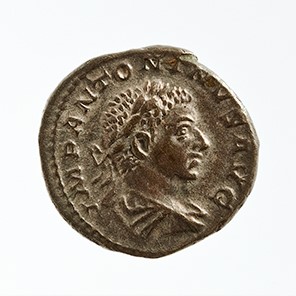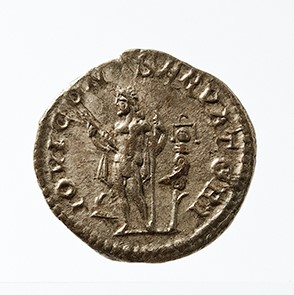Acquisition number: 1966.55
Obv.: Bust of Elagabalus r., laureate, draped. IMP(erator) ANTONINVS AVG(ustus).
Rev.: Jupiter standing l., naked with cloak behind, with thunderbolt in left hand, sceptre (spear?) in right; standard to the right and eagle to the left, at feet. IOVI CONSERVATORI.
Title: Denarius of Elagabalus - 1966.55
Acquisition number: 1966.55
Author or editor: Beryl Rawson
Culture or period: Roman Imperial
Date: AD 218-222
Material: Metal - Silver
Object type: Coins - Roman
Dimensions: 17mm (w)
Origin region or location: Italy
Origin city: Rome
Display case or on loan: 7
Keywords: Coin, denarius, Roman, Imperial, Elagabalus, Jupiter
Seaby, H.A., Roman Silver Coins (London, B.A. Seaby, 1967) III 68a; Mattingly, H., E.A. Sydenham, C.H. Sutherland, R.A. Carson, The Roman Imperial Coinage 13 vols (London, Spink, 1923-1994) IV p34, 91(b); Mattingly, H.,Coins of the Roman Empire in the British Museum, 6 vols (London, 1965) 142; Robertson, A. Roman Imperial Coins in the Hunter Coin Cabinet, University of Glasgow 5 vols (Oxford: Oxford University Press, 1962-1982) III 115 no. 31 and pl. 35.
1966.55
Denarius of Elagabalus
2.992 g. AD 218-222
Obv.: Bust of Elagabalus r., laureate, draped. IMP(erator) ANTONINVS AVG(ustus).
Rev.: Jupiter standing l., naked with cloak behind, with thunderbolt in left hand, sceptre (spear?) in right; standard to the right and eagle to the left, at feet. IOVI CONSERVATORI.
Within a year of Caracalla’s death (AD 217) Elagabalus became emperor, helped by the influence of his grandmother Julia Maesa (sister of Julia Domna, for whom see 1966.52). He adopted the Antonine name from Caracalla. He was murdered in AD 222.
Elagabalus came from Emesa in Syria and promoted the worship of the Sun-god, from whom he took his name Elagabalus (which does not appear as part of his title on coinage). On this coin, ‘Jupiter the Preserver’ may be identified with the Sun-god.
The military trappings on the reverse are perhaps an attempt to compensate for Elagabalus’ lack of military interest or experience. His appointment of his cousin Severus Alexander as Caesar in AD 221 quietened discontent in the army.
Seaby, H.A., Roman Silver Coins (London, B.A. Seaby, 1967) III 68a; Mattingly, H., E.A. Sydenham, C.H. Sutherland, R.A. Carson, The Roman Imperial Coinage 13 vols (London, Spink, 1923-1994) IV p34, 91(b); Mattingly, H.,Coins of the Roman Empire in the British Museum, 6 vols (London, 1965) 142; Robertson, A. Roman Imperial Coins in the Hunter Coin Cabinet, University of Glasgow 5 vols (Oxford: Oxford University Press, 1962-1982) III 115 no. 31 and pl. 35.

